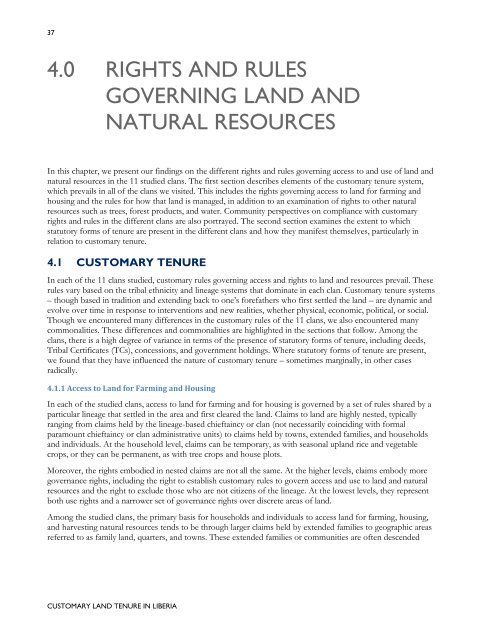Customary Land Tenure in Liberia - Land Tenure and Property ...
Customary Land Tenure in Liberia - Land Tenure and Property ...
Customary Land Tenure in Liberia - Land Tenure and Property ...
You also want an ePaper? Increase the reach of your titles
YUMPU automatically turns print PDFs into web optimized ePapers that Google loves.
37<br />
4.0 RIGHTS AND RULES<br />
GOVERNING LAND AND<br />
NATURAL RESOURCES<br />
In this chapter, we present our f<strong>in</strong>d<strong>in</strong>gs on the different rights <strong>and</strong> rules govern<strong>in</strong>g access to <strong>and</strong> use of l<strong>and</strong> <strong>and</strong><br />
natural resources <strong>in</strong> the 11 studied clans. The first section describes elements of the customary tenure system,<br />
which prevails <strong>in</strong> all of the clans we visited. This <strong>in</strong>cludes the rights govern<strong>in</strong>g access to l<strong>and</strong> for farm<strong>in</strong>g <strong>and</strong><br />
hous<strong>in</strong>g <strong>and</strong> the rules for how that l<strong>and</strong> is managed, <strong>in</strong> addition to an exam<strong>in</strong>ation of rights to other natural<br />
resources such as trees, forest products, <strong>and</strong> water. Community perspectives on compliance with customary<br />
rights <strong>and</strong> rules <strong>in</strong> the different clans are also portrayed. The second section exam<strong>in</strong>es the extent to which<br />
statutory forms of tenure are present <strong>in</strong> the different clans <strong>and</strong> how they manifest themselves, particularly <strong>in</strong><br />
relation to customary tenure.<br />
4.1 CUSTOMARY TENURE<br />
In each of the 11 clans studied, customary rules govern<strong>in</strong>g access <strong>and</strong> rights to l<strong>and</strong> <strong>and</strong> resources prevail. These<br />
rules vary based on the tribal ethnicity <strong>and</strong> l<strong>in</strong>eage systems that dom<strong>in</strong>ate <strong>in</strong> each clan. <strong>Customary</strong> tenure systems<br />
– though based <strong>in</strong> tradition <strong>and</strong> extend<strong>in</strong>g back to one‟s forefathers who first settled the l<strong>and</strong> – are dynamic <strong>and</strong><br />
evolve over time <strong>in</strong> response to <strong>in</strong>terventions <strong>and</strong> new realities, whether physical, economic, political, or social.<br />
Though we encountered many differences <strong>in</strong> the customary rules of the 11 clans, we also encountered many<br />
commonalities. These differences <strong>and</strong> commonalities are highlighted <strong>in</strong> the sections that follow. Among the<br />
clans, there is a high degree of variance <strong>in</strong> terms of the presence of statutory forms of tenure, <strong>in</strong>clud<strong>in</strong>g deeds,<br />
Tribal Certificates (TCs), concessions, <strong>and</strong> government hold<strong>in</strong>gs. Where statutory forms of tenure are present,<br />
we found that they have <strong>in</strong>fluenced the nature of customary tenure – sometimes marg<strong>in</strong>ally, <strong>in</strong> other cases<br />
radically.<br />
4.1.1 Access to <strong>L<strong>and</strong></strong> for Farm<strong>in</strong>g <strong>and</strong> Hous<strong>in</strong>g<br />
In each of the studied clans, access to l<strong>and</strong> for farm<strong>in</strong>g <strong>and</strong> for hous<strong>in</strong>g is governed by a set of rules shared by a<br />
particular l<strong>in</strong>eage that settled <strong>in</strong> the area <strong>and</strong> first cleared the l<strong>and</strong>. Claims to l<strong>and</strong> are highly nested, typically<br />
rang<strong>in</strong>g from claims held by the l<strong>in</strong>eage-based chiefta<strong>in</strong>cy or clan (not necessarily co<strong>in</strong>cid<strong>in</strong>g with formal<br />
paramount chiefta<strong>in</strong>cy or clan adm<strong>in</strong>istrative units) to claims held by towns, extended families, <strong>and</strong> households<br />
<strong>and</strong> <strong>in</strong>dividuals. At the household level, claims can be temporary, as with seasonal upl<strong>and</strong> rice <strong>and</strong> vegetable<br />
crops, or they can be permanent, as with tree crops <strong>and</strong> house plots.<br />
Moreover, the rights embodied <strong>in</strong> nested claims are not all the same. At the higher levels, claims embody more<br />
governance rights, <strong>in</strong>clud<strong>in</strong>g the right to establish customary rules to govern access <strong>and</strong> use to l<strong>and</strong> <strong>and</strong> natural<br />
resources <strong>and</strong> the right to exclude those who are not citizens of the l<strong>in</strong>eage. At the lowest levels, they represent<br />
both use rights <strong>and</strong> a narrower set of governance rights over discrete areas of l<strong>and</strong>.<br />
Among the studied clans, the primary basis for households <strong>and</strong> <strong>in</strong>dividuals to access l<strong>and</strong> for farm<strong>in</strong>g, hous<strong>in</strong>g,<br />
<strong>and</strong> harvest<strong>in</strong>g natural resources tends to be through larger claims held by extended families to geographic areas<br />
referred to as family l<strong>and</strong>, quarters, <strong>and</strong> towns. These extended families or communities are often descended<br />
CUSTOMARY LAND TENURE IN LIBERIA

















